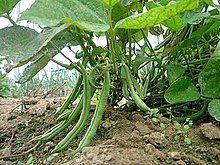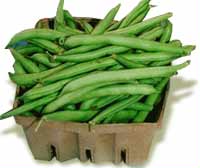Green bean
The examples and perspective in this article may not represent a worldwide view of the subject. (June 2015) |



Green beans, also known as string beans, or snap beans in the northeastern and western United States, are the unripe fruit and protective pods of various cultivars of the common bean (Phaseolus vulgaris).[1][2]
They are distinguished from the many differing varieties of beans primarily grown for their dried seeds in that green beans are harvested and consumed with their enclosing pods, typically before the seeds inside have fully matured. This practice is analogous to the harvesting of unripened snow pea pods or sugar snap peas of the pea family of plants. Popular green bean cultivars have been selected especially for the fleshiness, flavor, or sweetness of their pods.
Haricots verts, French for "green beans" (also known as French beans, French green beans, French filet beans, or fine beans (British English)) is a variety of green beans that is longer, thinner, crisper, and more tender than "standard" green beans.[citation needed] It is different from the haricot bean, which is sold as a dried seed.
Culinary use
| Nutritional value per 100 g (3.5 oz) | |||||||||||||||||||||||||||||||||||||||||||||
|---|---|---|---|---|---|---|---|---|---|---|---|---|---|---|---|---|---|---|---|---|---|---|---|---|---|---|---|---|---|---|---|---|---|---|---|---|---|---|---|---|---|---|---|---|---|
| Energy | 131 kJ (31 kcal) | ||||||||||||||||||||||||||||||||||||||||||||
6.97 g | |||||||||||||||||||||||||||||||||||||||||||||
| Dietary fiber | 2.7 g | ||||||||||||||||||||||||||||||||||||||||||||
0.22 g | |||||||||||||||||||||||||||||||||||||||||||||
1.83 g | |||||||||||||||||||||||||||||||||||||||||||||
| |||||||||||||||||||||||||||||||||||||||||||||
| Other constituents | Quantity | ||||||||||||||||||||||||||||||||||||||||||||
| Fluoride | 19 µg | ||||||||||||||||||||||||||||||||||||||||||||
| †Percentages estimated using US recommendations for adults,[3] except for potassium, which is estimated based on expert recommendation from the National Academies.[4] | |||||||||||||||||||||||||||||||||||||||||||||
Green beans are eaten around the world, and are marketed canned, frozen, and fresh. Green beans are often steamed, boiled, stir-fried, or baked in casseroles. A dish with green beans popular throughout the United States, particularly at Thanksgiving, is green bean casserole, which consists of green beans, cream of mushroom soup, and French fried onions.[5]
Some US restaurants serve green beans that are battered and fried, and Japanese restaurants in the US frequently serve green bean tempura. Green beans are also sold dried, and fried with vegetables such as carrots, corn, and peas.
Many but not all bean pods contain a "string", a hard fibrous strand running the length of the pod. This is often removed before cooking, or may be made edible by cutting the pod into short segments. The first "stringless" bean was bred in 1894 by Calvin Keeney, called the "father of the stringless bean", while working in Le Roy, New York.[6]
Chemistry
This section needs expansion. You can help by adding to it. (June 2015) |
The flavonol miquelianin (Quercetin 3-O-glucuronide) can be found in green beans.[7]
Cultivation
This section needs expansion. You can help by adding to it. (June 2015) |
Green beans are classified into two major groups, "bush" beans and "pole" beans.[8]
Bush beans are short plants, growing to approximately 2 feet (61 cm) in height, without requiring supports. They generally reach maturity and produce all of their fruit in a relatively short period of time, then cease to produce. Gardeners may grow more than one crop of bush beans in a season.
Pole beans have a climbing habit and produce a twisting vine, which must be supported by trellises, cages, or other means.. Runner beans have a similar habit but are a different species of bean.
Varieties
Over 130 varieties of green bean are known.[9] Varieties specialized for use as green beans, selected for the succulence and flavor of their pods, are the ones usually grown in the home vegetable garden, and many varieties exist. Pod color can be green, purple, red, or streaked. Shapes range from thin "fillet" types to wide "romano" types and more common types in between.
The following varieties are among the most common and widely grown in the US. Closely related varieties are listed on the same line.
Bush types
- Bountiful, 50 days (green, heirloom)
- Burpee's Stringless Green Pod, 50 days (green, heirloom)[6]
- Contender, 50 days (green)
- Topcrop, 51 days (green), 1950 AAS winner
- Red Swan, 55 days (red)
- Blue Lake 274, 58 days (green)
- Maxibel, 59 days (green fillet)
- Roma II, 59 days (green romano)
- Improved Commodore / Bush Kentucky Wonder, 60 days (green), 1945 AAS winner
- Dragon's Tongue, 60 days (streaked)
- Jade / Jade II, 65 days (green)
Pole types
- Blue Lake, 60 days (green)
- Fortex, 60 days (green fillet)
- Kentucky Blue, 63 days (green), 1991 AAS winner
- Old Homestead / Kentucky Wonder, 65 days (green, heirloom)
- Rattlesnake, 72 days (streaked, heirloom)
- Purple King, 75 days (purple)
- Witsa, 70-80 days (green, hairless). Witsa is available in South Africa, uncommon elsewhere.
Production
According to UN Food and Agriculture Organization (FAOSTAT), the top producers of green beans (in metric tonnes) in 2012.[10]
| Rank | Country | Production (t) |
|---|---|---|
| 1 | 16,200,000 | |
| 2 | 871,170 | |
| 3 | 620,000 | |
| 4 | 614,960 | |
| 5 | 305,000 | |
| 6 | 251,279 | |
| 7 | 165,400 | |
| 8 | 134,124 | |
| 9 | 133,744 | |
| 10 | 94,356 | |
| World | 20,742,857 |
References
- ^ "Green Beans".
- ^ "Beans - Vegetable Directory - Watch Your Garden Grow - University of Illinois Extension".
- ^ United States Food and Drug Administration (2024). "Daily Value on the Nutrition and Supplement Facts Labels". FDA. Archived from the original on 2024-03-27. Retrieved 2024-03-28.
- ^ National Academies of Sciences, Engineering, and Medicine; Health and Medicine Division; Food and Nutrition Board; Committee to Review the Dietary Reference Intakes for Sodium and Potassium (2019). Oria, Maria; Harrison, Meghan; Stallings, Virginia A. (eds.). Dietary Reference Intakes for Sodium and Potassium. The National Academies Collection: Reports funded by National Institutes of Health. Washington, DC: National Academies Press (US). ISBN 978-0-309-48834-1. PMID 30844154. Archived from the original on 2024-05-09. Retrieved 2024-06-21.
- ^ Cook's Illustrated (2004). The New Best Recipe. America's Test Kitchen.
- ^ a b Taylor's guide to heirloom vegetables. Boston: Houghton Mifflin. 1996. ISBN 0-395-70818-4.
- ^ Antioxidant properties of flavonol glycosides from green beans. Plumb G.W., Price K.R. and Williamson G., Redox Report, Volume 4, Number 3, June 1999 , pages 123-127, doi:10.1179/135100099101534800
- ^ McGee, Rose Marie Nichols; Stuckey, Maggie (2002). The Bountiful Container. Workman Publishing.
- ^ Facciola, Stephen (1998). Cornucopia II : a source book of edible plants. Kampong Publications. ISBN 0-9628087-2-5.
- ^ "Production of Green Bean by countries". UN Food and Agriculture Organization. 2011. Retrieved 2015-02-02.
